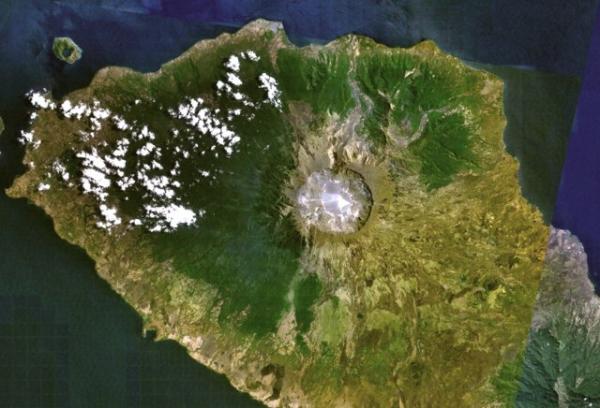
Rumbling Indonesian Volcano Not Likely to Repeat Deadly Blast

Mount Tambora in Indonesia has been stirring lately, but don't expect another massive eruption from the so-called "world's deadliest volcano," one scientist said.
Tambora is famous for its 1815 eruption, the largest in recorded history , according to the Smithsonian's Global Volcanism Program. Tambora is a stratovolcano that forms the entire 37-mile- (60-kilometer) wide Sanggar Peninsula on northern Sumbawa Island. The 1815 eruption was so massive that pyroclastic flows fast-traveling streams of hot ash and rock reached the sea on all sides of the peninsula, killing 60,000 people.
The sulfur dioxide and other chemicals that the eruption spewed into the atmosphere circled the planet, blocking sunlight and cooling Earth's average temperature, creating a so-called "year without summer."
"It makes the St. Helens eruption look small," said Erik Klemetti, a volcanologist at Denison University in Granville, Ohio, and the author of the Big Think's Eruption's blog.
But Tambora's eruptions aren't always so huge, and there's no reason to think any looming eruption would be so deadly. In fact, having had such a large eruption as recently as 1815 (geologically speaking) makes it less likely that a similar eruption will happen anytime soon, Klemetti said. [Related: The World's Five Most Active Volcanoes ]
The volcano has had at least three smaller eruptions since 1815. The 1815 eruption was rated a 7 on the Volcanic Explosively Index (VEI), a classification system somewhat akin to the magnitude scale for earthquakes. The highest VEI is 8. The later eruptions were of VEI 0-2, mostly small eruptions from vents along the mountainside and lava flows. Tambora is thought to have last erupted around 1967.
Any new eruption would likely be similar to these smaller eruptions, because as with most volcanoes, there are long periods between huge eruptions, which take time to build up. For very large eruptions, the period in between can be upwards of hundreds to thousands of years.
Sign up for the Live Science daily newsletter now
Get the world’s most fascinating discoveries delivered straight to your inbox.
Still, when a volcano with such a deadly past starts rumbling, people take notice. Indonesian volcanologists recently raised the alert level at the volcano due to an increase in shallow volcanic earthquakes and steam plumes rising from the caldera (large volcanic crater). When a volcano's alert level is raised, it's because officials want people to be aware of the threat of a potential eruption, not that something catastrophic is about happen.
"Although something big and bad at Tambora did happen in the recent past, there's no suggestion that what's going on there is going to be big and bad," Klemetti told OurAmazingPlanet.
- Image Gallery: Volcanoes from Space
- 7 Ways the Earth Changes in the Blink of an Eye
- 7 Most Dangerous Places on Earth
You can follow OurAmazingPlanet staff writer Brett Israel on Twitter: @btisrael. Follow OurAmazingPlanet for the latest in Earth science and exploration news on Twitter @OAPlanet and on Facebook.










